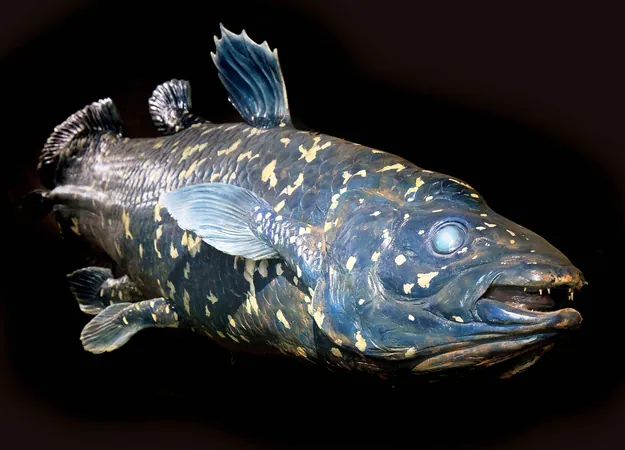
The Astonishing Tale of the Coelacanth: A Fish Thought Extinct for 60 Million Years Makes a Splash!
2025-03-22
Author: Ting
The vast and mysterious ocean has always held secrets that baffle scientists and ignite the imagination of enthusiasts. One such secret was recently brought to light—the remarkable coelacanth, a fish believed to have been extinct for 60 million years until its unexpected rediscovery.
Prior to 1938, this ancient fish was classified as a prime example of extinction, with experts asserting it had disappeared from the Earth about 65 to 70 million years ago. The prevailing theory was that it belonged to a lineage that had vanished along with the dinosaurs at the end of the Cretaceous period. But everything changed when a museum employee named Marjorie Courtenay-Latimer stumbled upon a peculiar specimen brought in by a local fisherman near the Chalumna River in East London, South Africa.
Courtenay-Latimer, intrigued by the unusual fish, sought confirmation from Professor James Leonard Brierley Smith, a renowned ichthyologist. To everyone’s astonishment, it was confirmed that the catch was indeed a living coelacanth, shattering the long-held belief of its extinction and rewriting the book on marine life's survival.
The term “Lazarus taxon” was then coined to describe species like the coelacanth that seemingly vanish from the fossil record only to be rediscovered later. Brierley Smith’s telegram declaring, “MOST IMPORTANT PRESERVE SKELETON AND GILLS = FISH DESCRIBED,” highlighted the significance of this find.
Fast forward to 1952, when two fishermen in the Comoro Islands netted a second specimen, further thrilling marine researchers and reinvigorating interest in this enigmatic fish. The excitement continued to grow when, in the 1990s, another species of coelacanth was discovered in Indonesia, known as Latimeria menadoensis, demonstrating that not only had the coelacanth survived, but it also had relatives that thrived in different waters.
The physical attributes of the coelacanth make it a fascinating subject for study. It features lobed pectoral fins reminiscent of the first vertebrates that transitioned onto land, offering a glimpse into the evolutionary past. This fish’s unique skull hinge has sparked debates among scientists regarding its feeding mechanisms, while its coloration provides notable camouflage in the rocky undersea habitats where it resides.
One of the coelacanth's survival strategies includes its tendency to rest in submerged lava caves during daylight hours, emerging only at night to hunt for prey. Such behavior minimizes encounters with predators and fosters a conservation of energy due to its low metabolic rate. This evolutionary design and stability of habitat have granted the coelacanth an ancient haven, safeguarded from the intense ecological pressures that many other marine species face.
Researchers classify the coelacanth in the group Sarcopterygii, or lobe-finned fishes, linking them to the earliest ancestors of land-dwelling animals—amphibians, reptiles, and mammals. This connection highlights the remarkable evolution of life from water to land, reminding us of the myriad possibilities that exist in nature.
As studies continue, scientists remain enthusiastic about exploring the deep-sea ecosystems that host the coelacanth, as these underwater realms may still harbor other creatures once thought to be lost to time. Each new finding pushes the boundaries of our understanding of marine biology, adaptation, and the evolution of life on Earth.
The rediscovery of the coelacanth serves as a powerful reminder of resilience and survival, captivating both the scientific community and those fascinated by the wonders of the natural world. As we delve deeper into the oceans, who knows what other astonishing connections to our planet’s history we may still uncover?
Stay tuned for further discoveries as the saga of the coelacanth continues to inspire curiosity and awe!


 Brasil (PT)
Brasil (PT)
 Canada (EN)
Canada (EN)
 Chile (ES)
Chile (ES)
 Česko (CS)
Česko (CS)
 대한민국 (KO)
대한민국 (KO)
 España (ES)
España (ES)
 France (FR)
France (FR)
 Hong Kong (EN)
Hong Kong (EN)
 Italia (IT)
Italia (IT)
 日本 (JA)
日本 (JA)
 Magyarország (HU)
Magyarország (HU)
 Norge (NO)
Norge (NO)
 Polska (PL)
Polska (PL)
 Schweiz (DE)
Schweiz (DE)
 Singapore (EN)
Singapore (EN)
 Sverige (SV)
Sverige (SV)
 Suomi (FI)
Suomi (FI)
 Türkiye (TR)
Türkiye (TR)
 الإمارات العربية المتحدة (AR)
الإمارات العربية المتحدة (AR)